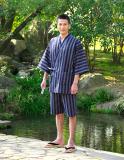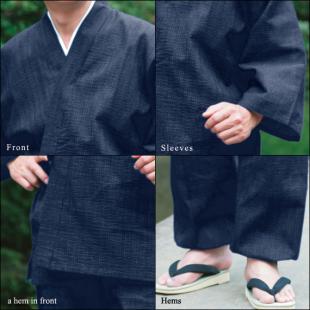Japanese Traditional Clothes: How to Stay Cool and Relax
What do you think of when you imagine traditional Japanese clothes? For most people, a kimono springs to mind but, given the Japanese climate with its hot and humid summers, it is not always practical and definitely not pleasant to wear layers of fabric bound tightly with a sash unless you want to melt. Traditional clothes are the answer to look cool and stay comfortable.
Cotton is King
Outside of the world of the wealthy classes, ordinary rural Japanese used to wear homespun hemp clothes, coloured with plant based dyes. When cotton started to be imported around the fifteenth century, it became the fabric of choice, being softer than hemp. Often dyed with indigo,which some say keep snakes away, cotton stayed in use for all informal and work clothing and still today, when you want to chill out, these traditional clothes are great to step into after a day on city streets.
Lounging Clothes
Do you know it is OK to wander round to your local store for a cold beer in your pyjamas? Well, it’s very OK, even cool, if you are wearing Japanese traditional cotton pyjamas or matching knee length pants and a loose, tied jacket known as jimbei. Once, only for men and children, today, girls and young women are often seen wearing them in the summer as they are relaxed and cool because of the ventilated jacket seams.
Zen Sophistication
When Buddhist monks were working in the temple gardens or on their knees scrubbing long, wooden corridors they are most likely to be wearing another traditional outfit called a samue. These also have a side-tied cotton jacket but the matching pants are full length, loose with ankle ties and have now become the mark of discerning taste. If you are a man or woman over a certain age, rather than loafing around at home in a colourful jimbei, join the elegant chic and wear a samue in quiet shades of grey, navy or brown.
The Must-have Japanese Outfit
Whatever your age or gender, the traditional garment you don’t want to be without is a yukata (see top of post). Yukata, like kimono, is full-length and wrap-around but tied with a much simpler sash or obi, and that’s where the similarity ends.These are the ideal summer clothes and are usually colourful cotton and definitely hot fashion items.You should team it with some wooden geta or casual sandals for cherry blossom viewing or for parties.In July, the thing to do is to rent a yukata and wear it to Kyoto’s Gion Festival, where everyone else in the city is out on the town for three days of partying and parading.Don’t forget your fan!By wearing these traditional outfits you will feel laid back and dressed to suit the climate.
About the Author
Mary Heerin is a freelance writer and editor whose first career was as an English-language educator. Though she is now based in the French Alps, she was a long-time resident of Kyoto, Japan.




